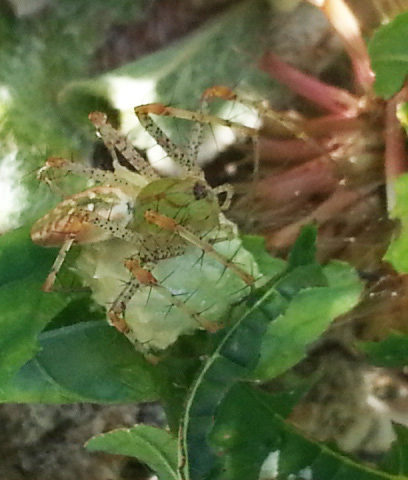Arachne
For those who don’t know the story, there was once a beautiful and talented weaver in ancient Greece named Arachne. She was so talented that the goddess Athena, also a weaver, challenged her to a weave-off. They both made four pieces. Athena’s pieces all extolled the wonders and goodness of the Greek pantheon, while those pieces woven by politically incorrect Arachne dared to point out that the gods, especially Athena’s father Zeus, weren’t really all that nice to the folks they ruled. This, and the fact that Arachne’s work was actually better than Athena’s, totally pissed off the goddess. To punish Arachne for her heresy, Athena turned the beautiful woman into a the world’s first spider, thus proving Arachne correct about the uncaring capriciousness of the gods.
Guess what this post is about? Spiders! That’s because I have a beautiful descendant of Arachne living in my front flower bed.
Before you shudder and decide you can’t bear to read this article, hold on a moment. First, you need to know that I dislike spiders as much as most people. I like what they do for me, but I really, really don’t want them crawling on me. Should one happen to appear on my body, I scream just like, well, just like the little girl I once was, the same girl who had to have one of her siblings knock a spider off her leg. The same girl who refuses to eat Alaskan King Crab, because I don’t want to eat a spider. Yuck.
Perhaps because I don’t use any modern chemical pesticides, I have an amazing assortment of spiders on my property. There are the usual venomous black widows and brown recluses, as well as the big wolf spiders and tarantulas, which the turkeys eat. And then there are all the rest.
Until I came to live here, I had no concept of how many shapes, sizes, and colors of spiders there are. At night, in the beam of my LED headlamp, the field spiders gleam like jewels–bright sapphire, deep ruby red, vibrant emerald green. I once found a canary yellow spider in my broccoli patch, eating yellow and black broccoli bugs. I wondered if that was why it was yellow. I have a ghost spider in the house, and yes, it is white. I once ended up with a white crab spider, which was about half the size of my palm, on my shoulder. Neither of us were particularly happy about the situation.
But the spider I saw two days ago on my struggling bee balm plant is truly unbelievable. She is a good-sized spider, with a leg span about the size of a silver dollar. But it’s her coloring that stunned me. Her head is a vivid green, her legs are cream and pink, while her cream-colored abdomen is patterned with what looks like a line of downward facing green leaves outlined in a beautiful pink. Those colors exactly match the colors of the bee balm leaves and flowers. Is a spider like a chameleon? Can she change colors to match her environment?
The moment I saw her, I knew I had to have a picture. I have a feeling she may be one of a kind. When I went back the next day with my phone, I discovered her previous big round abdomen had given way to an egg sack just about the same size. Looking much slimmer now, she spends her day crouched on top of the massive sack. As I turned the leaf trying to catch a photo, she moved with the plant, trying to protect her children from me. Because she doesn’t have a web, at least that I can see, I’m guessing she’s not a web spinner, but a free hunting spider. But I really don’t know that.
If anyone out there can identify her, I’d love to know what she is and why she’s so perfectly camouflaged in that specific plant. Even if I never identify her, I’m proud of myself. I’m actually enjoying one of Arachne’s amazing descendants.
ADDED NOTE: She has been identified as a Green Lynx spider, a fearsome hunter, just as I suspected. Her Wikipedia article says that: “Late in the season Peucetia viridans is prone to change its colour from predominantly green to paler yellow, typically with streaks of reddish, suggesting degradation of the tetrapyrrole pigment in the blood. Gravid females may change their color to fit their background.” So, she is indeed a chameleon, but only when she’s pregnant.

